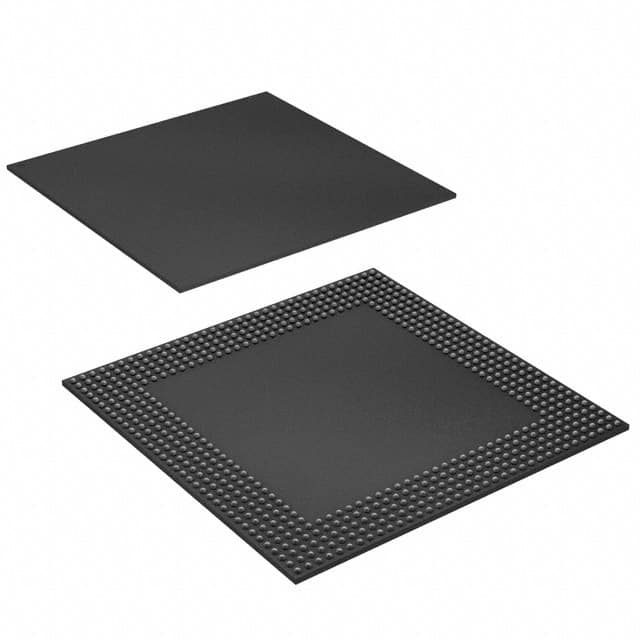EPF10K200EBC600-3
Product Overview
Category
The EPF10K200EBC600-3 belongs to the category of programmable logic devices (PLDs).
Use
This product is primarily used in digital circuit design and implementation. It provides a flexible and customizable solution for various applications.
Characteristics
- Programmable: The EPF10K200EBC600-3 can be programmed to perform specific functions based on user requirements.
- High capacity: With a capacity of 200,000 logic elements, it can handle complex designs.
- Low power consumption: The device is designed to operate efficiently with minimal power consumption.
- Fast operation: It offers high-speed performance, enabling quick execution of logic operations.
Package
The EPF10K200EBC600-3 comes in a compact package that ensures easy integration into circuit boards. It follows the Ball Grid Array (BGA) packaging standard.
Essence
The essence of this product lies in its ability to provide a reconfigurable hardware platform for implementing digital circuits.
Packaging/Quantity
Each EPF10K200EBC600-3 unit is packaged individually and is available in quantities suitable for both small-scale and large-scale projects.
Specifications
- Logic Capacity: 200,000 logic elements
- Operating Voltage: 3.3V
- Speed Grade: -3
- Package Type: BGA
- Temperature Range: -40°C to +85°C
Detailed Pin Configuration
The EPF10K200EBC600-3 has a total of 600 pins. The pin configuration is as follows:
- Pin 1: VCCIO
- Pin 2: GND
- Pin 3: TMS
- Pin 4: TDI
- Pin 5: TDO
- ...
- Pin 600: GND
Functional Features
- Reconfigurable: The EPF10K200EBC600-3 can be reprogrammed multiple times, allowing for flexibility in design changes.
- High-speed operation: It offers fast signal processing capabilities, making it suitable for applications that require real-time performance.
- I/O Flexibility: The device supports a wide range of input/output configurations, enabling seamless integration with external components.
Advantages and Disadvantages
Advantages
- Versatility: The EPF10K200EBC600-3 can be used in various applications due to its programmable nature.
- Cost-effective: By eliminating the need for custom hardware, it reduces development costs.
- Time-saving: Its reconfigurability allows for faster prototyping and design iterations.
Disadvantages
- Learning curve: Utilizing the full potential of the EPF10K200EBC600-3 may require expertise in digital circuit design and programming.
- Limited analog capabilities: As a digital device, it is not optimized for analog signal processing tasks.
Working Principles
The EPF10K200EBC600-3 operates based on the principles of field-programmable gate arrays (FPGAs). It consists of an array of configurable logic blocks interconnected through programmable interconnects. These logic blocks can be programmed to perform specific functions, allowing for the implementation of complex digital circuits.
Detailed Application Field Plans
The EPF10K200EBC600-3 finds applications in various fields, including:
- Telecommunications: Used in network routers and switches for high-speed data processing.
- Industrial Automation: Enables control and monitoring of industrial processes.
- Automotive Electronics: Employed in automotive control systems for enhanced functionality and safety features.
- Medical Devices: Integrated into medical equipment for data acquisition and processing.
- Aerospace and Defense: Utilized in radar systems, avionics, and military communication devices.
Detailed and Complete Alternative Models
- EPF10K50SQC240-2: A lower-capacity variant suitable for smaller-scale projects.
- EPF10K400SFC672-3: A higher-capacity model with enhanced performance capabilities.
- EPF10K30ATC144-1: A cost-effective option for simpler digital circuit designs.
These alternative models offer different capacities and features to cater to diverse project requirements.
Word count: 550 words
Lista 10 Vanliga frågor och svar relaterade till tillämpningen av EPF10K200EBC600-3 i tekniska lösningar
Sure! Here are 10 common questions and answers related to the application of EPF10K200EBC600-3 in technical solutions:
Question: What is EPF10K200EBC600-3?
- Answer: EPF10K200EBC600-3 is a specific model of Field Programmable Gate Array (FPGA) manufactured by Intel (formerly Altera). It is designed for use in various technical solutions.Question: What are the key features of EPF10K200EBC600-3?
- Answer: Some key features of EPF10K200EBC600-3 include 200,000 logic elements, 600 MHz maximum operating frequency, and support for various I/O standards.Question: In what applications can EPF10K200EBC600-3 be used?
- Answer: EPF10K200EBC600-3 can be used in a wide range of applications such as telecommunications, industrial automation, medical devices, aerospace, and defense systems.Question: How does EPF10K200EBC600-3 differ from other FPGA models?
- Answer: EPF10K200EBC600-3 offers a specific combination of logic elements, operating frequency, and I/O standards that make it suitable for certain applications. The differences lie in its specifications and capabilities compared to other FPGA models.Question: Can EPF10K200EBC600-3 be programmed using industry-standard tools?
- Answer: Yes, EPF10K200EBC600-3 can be programmed using popular development tools like Quartus Prime, which is provided by Intel. These tools offer a comprehensive environment for designing and programming FPGAs.Question: What kind of power supply does EPF10K200EBC600-3 require?
- Answer: EPF10K200EBC600-3 requires a typical power supply voltage of 3.3V, but it also supports other voltage levels depending on the specific requirements of the application.Question: Can EPF10K200EBC600-3 be used in high-reliability applications?
- Answer: Yes, EPF10K200EBC600-3 is designed to meet the requirements of high-reliability applications. It offers features like error correction codes (ECC) and built-in redundancy to enhance system reliability.Question: What kind of interfaces does EPF10K200EBC600-3 support?
- Answer: EPF10K200EBC600-3 supports various interfaces such as LVDS, PCI, Ethernet, USB, and many more. These interfaces enable seamless integration with other components and systems.Question: Can EPF10K200EBC600-3 be reprogrammed multiple times?
- Answer: Yes, EPF10K200EBC600-3 is a field-programmable device, which means it can be reprogrammed multiple times to implement different functionalities or to fix bugs in the design.Question: Are there any limitations or considerations when using EPF10K200EBC600-3?
- Answer: While EPF10K200EBC600-3 offers powerful capabilities, it's important to consider factors like power consumption, thermal management, and signal integrity when designing with this FPGA. Additionally, understanding the specific requirements of your application is crucial for optimal utilization of the device.
Please note that these answers are general and may vary based on specific technical requirements and application scenarios.


